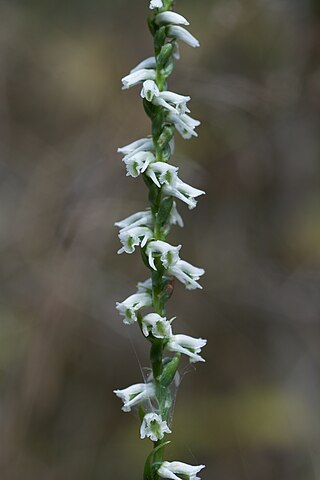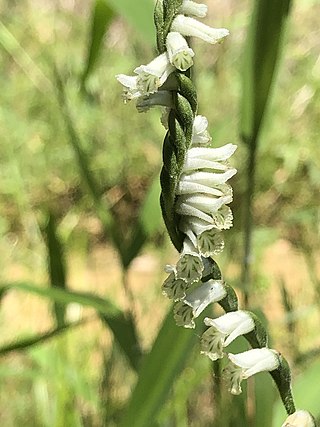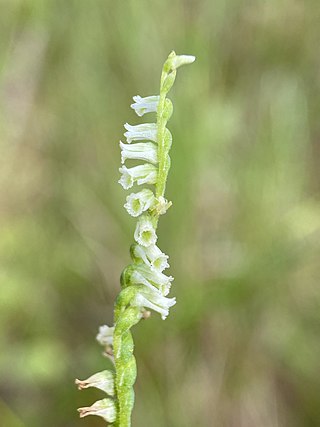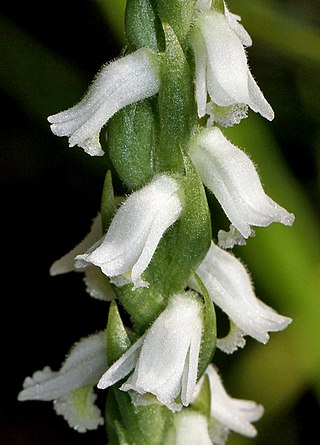
Spiranthes is a genus of orchids in the subfamily Orchidoideae. They are known commonly as ladies tresses, ladies'-tresses, or lady's tresses. The genus is distributed in the Americas, Eurasia, and Australia. The genus name Spiranthes is derived from the Greek speira ("coil") and anthos ("flower"), and was inspired by the spirally arranged inflorescence.

Spiranthes romanzoffiana, commonly known as hooded lady's tresses or Irish lady's-tresses, is a species of orchid. Collected by Chamisso during the Romanzov expedition it was described by him in 1828 and named for Count Nikolay Rumyantsev who financed the expedition. This orchid is native to North America, Ireland and the British Isles.

Spiranthes cernua, commonly called nodding lady's tresses, or nodding ladies' tresses, is a species of orchid occurring from Maritime Canada to the eastern and southern United States. As the common name suggests cernua means "nodding", or "bowed" in Latin.

Spiranthes ochroleuca, commonly called the yellow nodding lady's tresses, is a species of orchid occurring from southeastern Canada to the eastern United States.

Spiranthes porrifolia is a species of orchid known by the common names creamy lady's tresses and western ladies' tresses. It is native to the western United States from Washington and Idaho to southern California. It can be found in moist habitats, such as mountain meadows, swamps, fens, and riverbanks. It is a perennial herb growing from a tuberous root system, reaching a maximum height around 60 cm (24 in). The leaves are mainly located around the base of the erect stem. They are linear or lance-shaped, or sometimes nearly oval. The top of the stem is occupied by the inflorescence, a dense spiral of many flowers. Each flower is somewhat tubular, with an upper and lower lip, and cream to yellowish in color.

Spiranthes lacera, commonly called the slender ladies'-tresses, is a species of orchid that is native to Eastern North America. It has a widespread range and is found in a variety of open habitats, both natural and disturbed. It produces a spiral of white flowers in the summer.

Spiranthes magnicamporum, commonly called the Great Plains lady's tresses, is a species of orchid that is native to North America. It is primarily native in the Great Plains, but there are outlying populations in the east in areas of former natural grassland, such as the Black Belt prairies of the Southeast. It is found in both fens and wet and dry prairies, often in calcareous soil.

Spiranthes odorata, marsh lady's tresses or common lady's tresses, is a species of flowering plant in the orchid family, native to the southeastern United States, from Texas eastwards and northwards to Delaware. It grows in moist, partially shaded environments with acidic or neutral soil.

Spiranthes australis, commonly known as austral ladies tresses, is a species of orchid that grows from southern Caspian Sea and Himalayan Mountains to the South-West Pacific and north throughout Japan. It has up to about ten leaves at the base of a flowering stem with up to sixty small pink and white flowers spirally arranged around it.

Spiranthes lucida, the shining ladies'-tresses, is a species of orchid native to northeastern North America.

Spiranthes arcisepala, the Appalachian ladies' tresses, is a species of flowering plant in the family Orchidaceae. This orchid is native to eastern North America. Long treated as part of Spiranthes cernua the species complex was reevaluated and Spiranthes arcisepala established as a separate species in 2017.

Spiranthes torta, the Southern ladies’ tresses, is a terrestrial orchid native to Florida, Mexico, Central America, the Caribbean Islands and Bermuda.

Spiranthes brevilabris, the short lipped ladies' tresses or Texas lady's tresses is a rare and endangered orchid native to the southeastern United States.

Spiranthes longilabris, the long lipped ladies' tresses is an orchid endemic to the southeastern United States.

Spiranthes praecox, the grass leaved ladies' tresses, green-vein ladies'-tresses or sometimes giant ladies' tresses is a terrestrial orchid endemic to the United States, growing on the eastern coastal plains and around the Gulf Coast.

Spiranthes sylvatica, the woodland ladies' tresses or pale-green ladies'-tresses is a terrestrial orchid endemic to the United States, very similar in appearance and range to Spiranthes praecox which it had been considered a variation of for a long time.

Spiranthes eatonii, commonly known as Eaton's ladies' tresses is a terrestrial orchid endemic to the United States, closely related to or a variation of Spiranthes lacera.

Spiranthes triloba, the panther ladies' tresses is a terrestrial orchid endemic to Florida.

Spiranthes casei, or Case's lady's tresses, is a species of orchid native to the northeastern United States and Canada.
Spiranthes igniorchis, or fire ladies' tresses, is a species of orchid endemic to Florida.


















